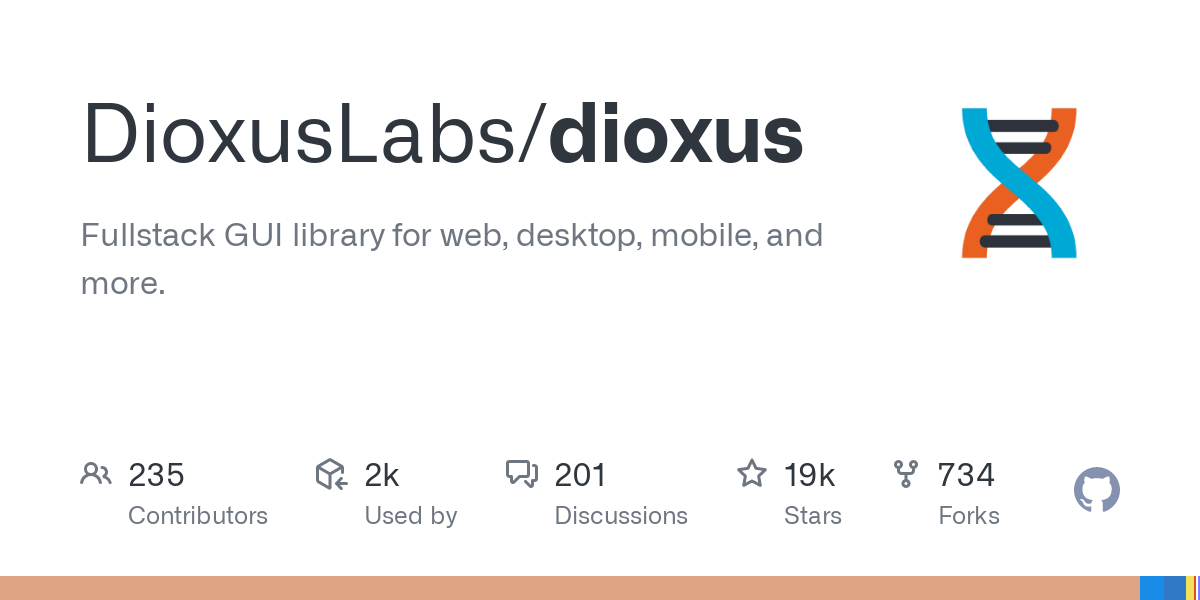Fullstack GUI library for web, desktop, mobile, and more. In Rust using a HTML + CSS renderer built on top of Servo.

Since people keep bringing up tauri, here’s the comparison made in the README:
Dioxus vs Tauri
Tauri is a framework for building desktop (and soon, mobile) apps where your frontend is written in a web-based framework like React, Vue, Svelte, etc. Whenever you need to do native work, you can write Rust functions and call them from your frontend.
-
Natively Rust: Tauri’s architecture limits your UI to either JavaScript or WebAssembly. With Dioxus, your Rust code is running natively on the user’s machine, letting you do things like spawning threads, accessing the filesystem, without any IPC bridge. This drastically simplifies your app’s architecture and makes it easier to build. You can build a Tauri app with Dioxus-Web as a frontend if you’d like.
-
Different scopes: Tauri needs to support JavaScript and its complex build tooling, limiting the scope of what you can do with it. Since Dioxus is exclusively focused on Rust, we’re able to provide extra utilities like Server Functions, advanced bundling, and a native renderer.
-
Shared DNA: While Tauri and Dioxus are separate projects, they do share libraries like Tao and Wry: windowing and webview libraries maintained by the Tauri team.
-

I seriously doubt that a dual-language platform is ever going to supplant Electron. Electron has the major advantage that the entire app is written in one language. And according to Stack Overflow’s 2023 developer survey, 66% of devs use JavaScript, 45% use Python, 43% use TypeScript, and 12% use Rust. More devs use Java, C#, C++, PHP, and C than Rust. So 2/3 of developers wouldn’t have to learn a new language to use Electron, and only a small fraction of the remainder knows Rust.

It’s not a dual-language platform, though. You write the backend and the frontend in Rust. The frontend code is compiled to WASM to serve it to the browser.

Ah, well that’s great for folks who already know or want to learn Rust

I wish we went the other way around: build for native and compile to HTML/CSS/WASM.
For me the disadvantage of Electron is well, it doesn’t have any advantage or performance improvement over the browser version for 99% of use cases, and when you shove that on a mobile phone it performs as horribly as the web version.
People already use higher level components that ends up shitting out HTML and CSS anyway, why not skip the middleman and just render the box optimally from the start? Web browsers have become good, but if you can skip parsing HTML and CSS entirely and also skip maintaining their state, that’s even better.
I had the misfortune of developing a React Native app, and I’d say thinking in terms of rows and columns and boxes was nice. Most of RN’s problems are because they still run JS and so you have to bundle node and have the native messaging bridge, and of course that it’s tied to the turd that is React. But zero complains about the UI part when it doesn’t involve the bridge: very smooth and snappy, much more than the browser. And the browser version was no different than standard React in performance.
I like that it’s not yet another Chromium one at least.

https://egui.rs/ promises to be able to do this, although I’m not positive it’s ready for primetime

egui is cool but it’s an immediate UI kind of thing, that’s usually used in video games as you’re constantly re-rendering the whole thing anyway.
A more fitting UI library would be Iced, which is also what System76 is building their COSMIC desktop environment on.
It does claim to support the web too, although not via HTML which brings some accessibility concerns. I’d expect performance to be very good otherwise.

Non dev here but curious, why does react suck?

For the end user, its main weakness is that complex pages can be pretty slow to render if not coded well. It’s not that bad either. You wouldn’t be like “oh this is a React site, yuck”, they’re all like that these days for the reasons you’d expect.
As for React Native, its main issue is the communication between the JavaScript browser-ish environment and the Java/Kotlin native environment that can be costly because every has to be serialized (meaning, converted to some type of data structure both sides can understand) and deserialized, so complex screen updates don’t scale too well.
It’s easy for developers to accidentally trigger much bigger and much more expensive rerenders than expected. If you see whole second long page hangs on some websites as new content loads in that’s usually what happened.
For developers, it’s complicated, you kind of need to experience it to understand the footguns.
React was born to solve one particular problem at Facebook: how can we make it so any developer can jump on any part of the UI code and add features without breaking everything. One of the most complicated aspects of a website is state management, in other words, making sure every part of the page are updated when something changes. For example, if you read a message in your inbox, the unread count needs to update a couple places on the page. That’s hard because you need to make sure everything that can change that count is in agreement with everything that displays that count.
React solves that problem by hiding it away from you. Its model is simple: given a set of inputs, you have a function that outputs how to display that. Every time the value changes, React re-renders every component that used that value, compares it with the previous result, and then modifies the page with the updated data. That’s why it’s called React, it reacts to changes and actions.
The downside of that is if you’re not very careful, you can place something in a non-ideal spot that can cascade into re-rendering the entire page every time that thing updates. At scale, it usually works out relatively okay, and it’s not like rendering the whole page is that expensive. There’s an upper cap on how bad it can be, it won’t let you do re-render loops, but it can be slow.
I regularly see startups with 25MB of JavaScript caused by React abuse and favoring new features over tracking down excessive renders. Loads the same data 5 times because “this should only render once” and that turned out to be false, but it displays correctly. I commonly see entire forms being re-rendered every character you type because the data is stored in the form’s state, so it has to re-render that entire tree.
But it’s not that bad. It’s entirely possible to make great and snappy sites with React. Arguably its problem isn’t React itself but how much it is associated with horrible websites because of how tolerant to bad code it is. It’s maybe a little bit too easy to learn, it gives bad developers an undeserved sense of confidence.
E: And we have better solutions to this such as signals which SolidJS, Vue and Svelte make heavy use of. Most of the advantages with less problems.
Anyway, that part wasn’t relevant at all why I don’t like React. The point is, skip the web, you don’t really need the web. React Native skipped the whole HTML part, it’s still JSX but for native app styled components for UI building. The web backend worked very well, your boxes became divs with some styles. It pretty much just worked. Do that but entirely in Rust since Rust can run natively on all platforms. Rust gets to skip all the compromises RN needed, and skip the embedded browser entirely. Make it desktop first then make the web version, it’ll run just as well and might even generate better code than if a human wrote it. Making the web look native sucks but making native fit web is a lot easier than it looks. Letting go of HTML and CSS was a good call from React Native.

i thought Tauri was the electron alternative we’ve been waiting for.

We’ve been using Leptos at work, which is a similar framework (and probably shares half the stack with Dioxus).
And yeah, it’s really good. My favorite thing about using Rust for the UI is algebraic data types.
So, in Rust when you call a function which can fail, there isn’t an exception being thrown, but rather you get aResult-type as return value.
ThisResultcan either contain anOkwith the actual return value inside. Or it can contain anErrwith an error message inside.
So, in your UI code, you just hand thisResultall the way to your display code and there you either display the value or you display the error.No more uninitialized variables, no more separate booleans to indicate that the variable is uninitialized, no more unreadable multi-line ternaries.
It just becomes so much simpler to load something from the backend and display it, which is kind of important in frontend code.
Probably not. Electron is popular not just for its cross-platform support, but also that its skills are highly transferable from existing web dev.

Awesome, I’m looking for frameworks like this, thanks for sharing.

Nah I ain’t about that rust life

server side rendering only?
…what is WRONG with you

